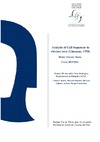Please use this identifier to cite or link to this item:
https://accedacris.ulpgc.es/jspui/handle/10553/74900
| DC Field | Value | Language |
|---|---|---|
| dc.contributor.advisor | Viera Rodríguez, María Ascensión | - |
| dc.contributor.advisor | Almunia Portolés, Javier | - |
| dc.contributor.author | Morales Maciá, Héctor Manuel | - |
| dc.date.accessioned | 2020-10-20T11:19:01Z | - |
| dc.date.available | 2020-10-20T11:19:01Z | - |
| dc.date.issued | 2016 | en_US |
| dc.identifier.uri | https://accedacris.ulpgc.es/handle/10553/74900 | - |
| dc.description.abstract | The orcas of Loro Parque and its facilities are an ideal platform for the study of the behaviour of this species. Through the present study it is possible to establish a criterion for the determination of call sequences starting from a comprehensive analysis of them sounds issued by the orcas. Counting on a network of intelligent hydrophones that allow the automatic detection of events of sounds emitted in the Orca Ocean pools is has been possible to carry out the classification and description of a wide variety of sounds. After the determination of the sequences and making an analysis of the durations in the patterns of transition between vocalisations, we have been able to establish a temporal separation between vocalisations that form a sequence, both individual and exchange. Thus, a temporal space around 1.73 s for individual sequences and 2.14 s for exchange sequences, which allows the identification of individual and exchange sequences without knowing the issuers. These results make it possible to develop a tool that will allow to apply in the near future this method in uncontrolled media and thereby facilitate and expand the bioacoustic study of Orcinus orca and a great variety of marine species. | en_US |
| dc.description.abstract | Las orcas del Loro Parque y las instalaciones en las que se encuentran suponen una plataforma idónea para el estudio del comportamiento de esta especie. Mediante el presente estudio se ha podido establecer un criterio para la determinación de secuencias de llamadas a partir de un análisis exhaustivo de los sonidos emitidos por las orcas. Contando con una red de hidrófonos inteligentes, que permiten la detección automática de los eventos de sonido emitidos en las piscinas del Orca Ocean, se ha podido llevar a cabo la clasificación y descripción de una amplia variedad de sonidos. Tras la determinación de las secuencias y haciendo un análisis de las duraciones en los patrones de transición entre vocalizaciones hemos podido establecer una separación temporal entre vocalizaciones que conforman una secuencia, tanto individual como de intercambio. Se ha establecido así, un espacio temporal en torno a 1.73 s para secuencias individuales y 2.14 s para secuencias de intercambio, lo cual permite identificar secuencias individuales y de intercambio sin conocer a los emisores. Estos resultados hacen posible desarrollar una herramienta que permitirá en un futuro próximo aplicar este método en medios no controlados y con ello facilitar y ampliar el estudio bioacústico de Orcinus orca y de una gran variedad de especies marinas. | en_US |
| dc.language | eng | en_US |
| dc.subject | 240102 Comportamiento animal | en_US |
| dc.subject.other | Orcinus Orca | en_US |
| dc.subject.other | Call sequences | en_US |
| dc.title | Analysis of Call Sequences in "Orcinus orca" (Linnaeus, 1758) | en_US |
| dc.type | info:eu-repo/semantics/bachelorThesis | en_US |
| dc.type | BachelorThesis | en_US |
| dc.contributor.departamento | Departamento de Biología | en_US |
| dc.contributor.facultad | Facultad de Ciencias del Mar | en_US |
| dc.investigacion | Ciencias | en_US |
| dc.type2 | Trabajo final de grado | en_US |
| dc.utils.revision | Sí | en_US |
| dc.identifier.matricula | TFT-37753 | es |
| dc.identifier.ulpgc | Sí | en_US |
| dc.contributor.buulpgc | BU-BAS | en_US |
| dc.contributor.titulacion | Grado en Ciencias del Mar | es |
| item.fulltext | Con texto completo | - |
| item.grantfulltext | restricted | - |
| crisitem.advisor.dept | GIR ECOAQUA: Ecofisiología de Organismos Marinos | - |
| crisitem.advisor.dept | IU de Investigación en Acuicultura Sostenible y Ec | - |
| Appears in Collections: | Trabajo final de grado Restringido ULPGC | |
Page view(s)
89
checked on Feb 24, 2024
Download(s)
11
checked on Feb 24, 2024
Google ScholarTM
Check
Share
Export metadata
Items in accedaCRIS are protected by copyright, with all rights reserved, unless otherwise indicated.
